A garden forever becoming

Susara Wessels's Stellenbosch garden is full of promise, with signs of new growth everywhere. Susara Wessels's Stellenbosch garden is full of promise, with signs of new growth everywhere.
Cape Town - It’s been a cold, wet and grey winter, but Susara Wessels’s Stellenbosch garden is full of promise, with signs of new growth everywhere.
“A garden forever becoming” is the poetic way she describes her garden.
A gnarled wisteria creeper, woody and intertwined, has been trained along the balcony. It is full of buds, with a few already bursting into the mauve flowers that will make a brilliant showing and smell sublime in the coming months.
The large plane tree is also budding, a few indigenous irises are starting to unfurl and the salvia has its first flowers.
It is the quiet time, before the riot of spring colour.
A garden is never finished, especially if you’re developing and tending it yourself, and Wessels’s garden is symbolic of her journey through life, she says.
“When I came here 10 years ago it was an old, exhausted garden. The good part was that there were big trees, and I didn’t have to wait for trees to grow.”
A few years back she removed all the lawns and the tarred road that led down the 7m slope to the parking area. The parking area was replaced with a labyrinth; she built a formal garden in a quincunx form in front of the house at the top, and a terraced garden joined the two.
“It was all clipped back and there was nothing here – and then the landscapers went bankrupt and left.”
Wessels was left with a bare framework, paths to build and lots of bare ground to fill with plants. In the two years since then, she’s created an abundant, beautiful garden.
“Initially I wanted a blue, white and pink garden, but the hibiscuses that were here were apricot. Now I have an apricot and purple garden.”
The quincunx is a form based on five points, one being the centre point. Wessels was inspired to build it after reading a book by Charles Palliser called The Quincunx.
“It was supposed to be a formal garden of roses and vegetables, but I can’t find it in my heart to take out the poppies, which come up on their own,” she says.
Pennyroyal lines the paths.
She planted about 45 roses, many of them Just Joeys, to fit in with her apricot colour scheme.
It made sense to plant roses and vegetables together, as they both need attention and care.
This section needs watering in summer and she uses her household’s grey water to do so.
She’s just planted a few anemones and pansies, protected from snails by broken eggshells. Last season’s spinach is ready to be taken out.
“I wanted creatures in my garden,” Wessels says, and they’re there: a large tortoise peeps from under a bush; a clay bowl has a dinosaur-like lizard crawling along its edge; and a wooden hippo is waiting to find its place.
The large plane tree is a strong feature of the middle section of the garden. In summer it will offer much-needed shade. Underneath it Wessels has planted plectranthus, buddleia and salvias. There’s an exceptionally pretty salvia with tiny red and white flowers, called Salvia microphylla, or “Hot Lips”.
Clivias are planted around the tree and there are many different lavenders.
“I didn’t want any lawns – you work hard to keep them green. In winter you’re almost there and then in summer they become less and less green, the thorns become more, and no one can play there anyway. Now I’ve got paths.”
Two paths on either side of the tree take you down to the labyrinth, which she was inspired to build after seeing the one at Rustenburg farm. A few Dietes grandiflora, the wild iris, are starting to flower around the labyrinth.
This area is hot in summer and wet in winter – moss is growing on the rocks here. The soil is clay and bakes in the sun. In the centre is Mondo grass, deep green and soft, which doesn’t need mowing.
Beyond the labyrinth is a magnificent Ficus tree, and next to it a shady bower; Wessels’s plans are for ferns and soft plants in this green cathedral.
Between the labyrinth and the top part of the garden is a 7m slope, and it is here Wessels has had her work cut out for her.
Fortunately she had a lot of monkey stone on the property to build the terraces, but had to bring in soil. “I wanted a green wall, and to go indigenous as far as possible.”
This area is filled with pelargoniums and succulents; a young camellia is in flower. There’re heliotrope, watsonias and the honey euryops – a branched, evergreen shrub with masses of small, yellow, honey-scented daisy flowers.
Snowdrops add a delicate touch here and there; irises are ready to break into flower.
“My garden has become a spiritual journey of living with myself,” says Wessels. “I walk in my garden regularly, and in summer when it is hot, I get up early. I’ve finally learnt to sit in the garden without feeling guilty about all that needs to be done. I can just sit here and be quiet.”
Tips for a glorious garden
* Live in your garden, observe it and see what flourishes and what struggles to survive.
* Observe seasonal changes, how the shade moves and where it gets hot, and plant accordingly.
* If you can read, you can cook, says Wessels. The same applies to gardening – read magazines for ideas and information about growing.
* Grow plants yourself from slips and seeds.
* Exchange plants with friends – gardening doesn’t have to be expensive.
* Visit other gardens for ideas.
* Be water-wise and grow indigenous plants. - Cape Argus